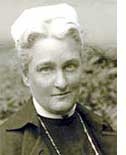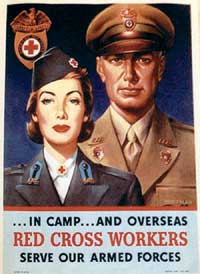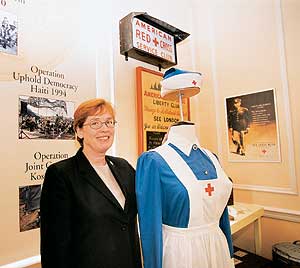The mission of the Red Cross is to bring medical aid, comfort, and compassion — a mission that closely aligns with the Johns Hopkins School of Nursing. It’s not surprising then, that the Red Cross has served as a magnet over the decades for Hopkins-educated nurses.

That was then:
She stares back from the photo with an almost unnerving confidence, her steady gaze seeming to bore through the viewer. The military style uniform, necktie, and hat bespeak authority. It is clear that this is a woman with important skills, with no time for the trivial. She is Clara Noyes, Class of 1896, director of American Red Cross Nursing (1919-1936) and she is the historical embodiment of a Red Cross nurse.
This is now:
She participates in a national disaster drill at the command center of the U.S. Department of Health and Human Services, planning the logistics of disaster preparedness. She wears a professional red suit with pumps and pearls, and she looks like the consummate executive that she is. She is Nancy McKelvey, Class of 1964, and she is today’s embodiment of a Red Cross nurse.
McKelvey, in fact, is the chief nurse, overseeing efforts of some 35,000 paid and volunteer American Red Cross nurses across the United States and representing the agency to other nursing and health organizations from the agency’s headquarters in Washington, DC. But McKelvey is quick to point out that there are many manifestations of the contemporary Red Cross nurse.

As an example, she points to another Hopkins alum, Jean Waldman, Class of 1964, who serves as a nursing historian for the Red Cross
on a volunteer basis. Dedicated to furthering our understanding of the roles nurses have played throughout history — particularly during World War I — Waldman has served as consultant to filmmakers. The producers of In Love and War, for instance, turned to her for advice in fleshing out the character of Agnes Von Kurowsky (played by Sandra Bullock), a Red Cross nurse who was Ernest Hemingway’s inspiration for the romantic interest in his classic, A Farewell to Arms. “Jean is a perfect example of how people can combine working for the Red Cross with whatever is their passion,” says McKelvey.
Over the years, Red Cross nurses have indeed been passionate, often dedicating their lives to health education, disaster relief, and care of the traumatized, sick and wounded, usually for little or no pay, and virtually no public acclaim.
From the very beginning of the American Red Cross Nursing Service, many of those Red Cross nurses have also been Johns Hopkins graduates or associates, forging a lasting relationship between two well-known institutions.
The exhaustive 1922 book, History of American Red Cross Nursing, by Hopkins assistant superintendent Lavinia Dock, was co-written by five others, including Hopkins graduates Noyes and Elizabeth Gorden Fox, Class of 1910, who became director of the American Red Cross Bureau of Public Health Nursing in 1919. The book invokes the image of the Good Samaritan to help explain why nursing is such an integral part of the American Red Cross: “The presence of the impersonal spirit of pity for and the desire to relieve alike both friend and foe is the essential characteristic of the Red Cross ideal, as it is also the true ideal in nursing.”
“I must get back to my work.”
Several of those who established the Johns Hopkins School for Nurses in 1889 also served on the committee that later organized the nursing division of the Red Cross, says Waldman, ensuring that the history of the two institutions would be inextricably entwined.
The founders ensured that the standards for becoming a Red Cross nurse were rigorous. “Not just anyone could join,” says Waldman. “You had to be a graduate of a certified school, your affiliated hospital had to have a certain number of patients, you had to have cared for a certain number of conditions, you had to write an essay, and you had to belong to the American Nurses Association. It was an honor to be a Red Cross nurse.”
Until the 1970s, nurses wore white uniforms and caps. Particularly in the early days of the Red Cross, a Johns Hopkins nursing cap was immediately identifiable. It was a mark of prestige, indicating that you worked with the nation’s nursing leaders and knew doctors with names like Welch or Osler. Other doctors and nurses took notice, says McKelvey.

The annals of Red Cross nursing are replete with the names of Hopkins nursing graduates, many of whom held key leadership positions (see sidebar), beginning with Noyes, who worked side by side with Jane Delano, the first director of American Red Cross nursing services. Noyes was the 1923 recipient of the Florence Nightingale Award, the highest nursing award from the International Red Cross. She had been head nurse at Hopkins for two years, and then worked with Delano at the Red Cross, where she succeeded her as the national director of nursing in 1919.
Both Delano and Noyes “nearly worked themselves to death,” says Waldman. Delano died of an infection in 1919 while reviewing base hospitals in Sevanay, France, during World War I. Her final words, reportedly were, “But what about my work? I must get back to my work.” After her death, she was honored not only by patients, other nurses, and American soldiers, but by German soldiers who saluted her funeral procession as it wound up a hill. She is buried in Arlington National Cemetery. Noyes died almost instantaneously in her car on her way to work in 1936, most likely from an aneurysm.
One event that tested them both was the influenza epidemic of 1918. The outbreak was so severe, and so many doctors and nurses were sick, that the Red Cross was desperate for health care workers. People were called upon to help even if they had had no formal health-care training and had merely taken a basic Red Cross course in “Home Hygiene and Care of the Sick.”
Red Cross nurses like Delano and Noyes were responsible for opening emergency hospitals, supplying nursing personnel, and furnishing emergency supplies—as well as taking care of routine tasks like serving food, making up Army cots, and cleaning and scrubbing. The History of American Red Cross Nursing records that, because of the strain, “Dark circles deepened under Miss Delano’s eyes, her usual kindliness of manner gave way now and then, deep lines appearing under her resolute mouth. But at no time in her entire Red Cross service was she less confident, less splendid in her sure and brilliant strength.” Noyes’ temperament, however, remained unflappable. The 1940 book Makers of Nursing History reports: “The stifling weather and fearful pressure of work which made others irritable and less efficient only seemed to deepen her silence and fortify her spirit.”

Healing on the front lines
The American Red Cross began in 1881 and the Spanish-American War in 1898 ushered in a new role for the organization: recruitment of nurses for wartime. The urgent need for nurses eventually led to the official formation of a nursing division in 1909.
Red Cross nurses knew that they could be called to serve in wartime, and serve they did. It’s impossible to know exactly how many Hopkins nurses served in the military, but the numbers undoubtedly peaked during World Wars I and II, says Waldman. The Red Cross was also initially responsible for organizing and staffing Army base hospitals, and Hopkins graduates were called upon to fill leadership positions.
In World War I, Bessie Baker, Class of 1902, was the chief nurse of Johns Hopkins Base Hospital No. 18, stationed primarily in Savenay, France. During World War II, Mary Sanders Price, Class of 1934, was the chief nurse of Hopkins’ 118th General Hospital, which operated first in Sydney, Australia, and then on the island of Leyte in the Philippines, by way of New Guinea.
“On the whole, you didn’t sign up to go to war, but you knew you could be called,” says Waldman. “The best and the brightest were put in a special [reserves] category where they had to agree that if the military wanted them, they would go.” Many ended up being absorbed into the military, becoming part of the Army or Navy Nurses Corp.
” Most of the nurses wanted to be on the front lines just for the excitement of it,” says Waldman, but she doubts that many really knew what they were getting into. “It was quite a change to go from working in pristine hospital conditions to working in the middle of a battlefield with mud up to your knees and no electricity. The conditions were often horrendous.” The prevalence of trench warfare during World War I meant that shrapnel and bombs rather than bullets caused most wounds. Poison gases were also a major source of injury.
In reports, Baker described how 250 men stumbled into Base Hospital No. 18 in 1918 with their faces blistered and burned by poison gas: “As we went around the wards, stepping over the stretchers, bending down to the floor with a hot drink, or with a match to light a cigarette for an armless man, we were almost ready to cry ‘quits’ at any cost. How savage, how inexpressibly futile has become this light valuation of human life!”
After World War I, some Red Cross nurses like Charlotte Heilman, Class of 1908, went to help European countries that had been devastated by the war. One Red Cross report gives a stirring description of post-World War I Europe:
” They all looked stunned and sullen, and no smile could be teased from them.… And in all the villages are the old, old people. They are so terrorized, so heartbroken there is nothing more that life can do to them. They do not seem to be asking for a place to live in but a place in which to die undisturbed.”
Red Cross nurses like Heilman, Alice Fitzgerald, Class of 1906, and others established homes for refugees and worked on tuberculosis prevention, child welfare, and rehabilitation of “war cripples.” They also started nursing schools.
“Nursing even in the United States was young, but in some of these countries they had no trained nurses,” explains Waldman.
In the United States, the Red Cross has always endeavored to train civilians in health care and hygiene, as well as provide health care in remote, underserved parts of the country. In the wake of World War I, Red Cross nurses pursued these kinds of public health tasks with zeal.
As described in the History of American Red Cross Nursing, “All over the country in the most out-of-the-way places, as well as in thriving agricultural centers, our nurses are at work. In the tiny settlements in the high Sierras, among Indian teepees, in the heart of the Appalachians, on the lonely islands off the New England coast, on the wind-swept plains of Montana, in the village along the Mexican border, in the heart of the forest of northern Michigan and in the mining camps of Kentucky and West Virginia, the chance to live, the message of health and the good will of the Red Cross are being carried by those brave, and often lonely workers, in the uniform of the nurse and of the Red Cross.”
Today, Red Cross nurses are involved in all service areas and at all levels of the humanitarian organization; some are salaried, but many are volunteers, says McKelvey. Some work at national headquarters, but most serve in local chapters or in “blood” regions, where they coordinate blood collections and provide community services. They teach disaster preparedness and CPR/first aid, and make themselves available for service in the event of a local disaster or emergency and for international relief efforts.
Last summer, McKelvey worked with three Johns Hopkins graduate students in the combined MSN/MPH program who are serving as interns in the Red Cross Office of the Chief Nurse.” Sara Russell and Judie Resick are assessing state nurse alert and mobilization plans and compiling a national database of disaster initiatives,” explains McKelvey. “Rachel Breman is assisting with project development to improve maternal-infant health in Ghana and will be traveling to Ghana to confer with members of the Ghanaian Red Cross.”
Deeply embedded in history and perpetuated by mutual goals, the unofficial partnership of Johns Hopkins and the American Red Cross endures.